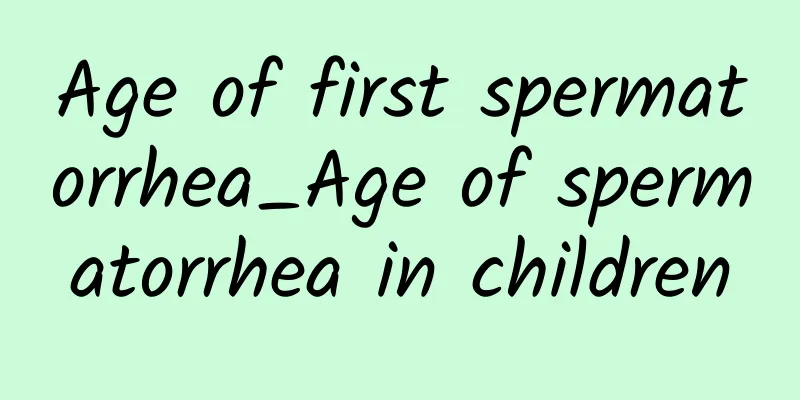Where is the scrotum?

|
Nowadays, the country has popularized nine-year compulsory education, and people's education level is gradually improving, but there are still many people who only understand the meaning of some spoken words and know very little about written words. Many people know the word scrotum, but they don't know where the scrotum refers to. The scrotum refers to the male testicles, which is part of the male reproductive organs. Let's learn more about it. 1. Testicles The testis is located in the scrotum, one on each side, and the left side is generally 1 cm lower than the right side. The testis is slightly flattened oval with a smooth surface, divided into inner and outer sides, front and back edges, and upper and lower ends. The front edge is free; the back edge has blood vessels, nerves and lymphatic vessels entering and exiting, and is in contact with the epididymis and the testicular part of the vas deferens. The upper end and the back edge are attached to the epididymis head, and the lower end is free. The outer side is convex and the inner side is flat. The testis grows rapidly with sexual maturity, and shrinks and becomes smaller with the decline of sexual function in old age. The surface of the testis is covered with a thick fibrous membrane called the tunica albuginea. Along the posterior edge of the testis, the tunica albuginea thickens and protrudes into the testis to form the septum testis. From the septum testis, many connective tissue septa extend, dividing the testis parenchyma into many testicular lobules. The testicular lobules contain convoluted seminiferous tubules, the epithelium of which can produce sperm. 2. Features Testicles are male internal reproductive organs. Normal men have two testicles, one on the left and one on the right side of the scrotum. Testicles are oval in shape and grayish white in color. Adult testicles are 3.5-4.5 cm long, 2-3 cm wide, and 1-2 cm thick. Each testicle weighs 10-15 grams. Generally, the left testicle is about 1 cm lower than the right testicle. Some people have one testicle that is larger than the other, or one that is higher than the other. If the difference is not too big, it is normal. There are a large number of curved seminiferous tubules in the testicles, which contain interstitial cells. The seminiferous tubules are where sperms are produced. The number of sperms produced in a person's lifetime is astonishing. A single ejaculation of 3-4 ml contains 300-400 million sperms, and as few as 100-200 million. The number of sperms produced in a lifetime can reach more than 1 trillion. Sperm production is easily affected by many factors such as temperature. If the temperature around the testicles is too high or affected by chemical toxins, sperm production will be impaired. Interstitial cells produce androgens, which are closely related to male secondary sexual characteristics and physiological functions. 3. Spermatogenesis The testis is composed of the seminiferous tubules and interstitial cells. The epithelium of the seminiferous tubules is composed of spermatogenic cells and supporting cells. The original spermatogenic cells are spermatogonia, which are attached to the basement membrane of the seminiferous tubules. Starting from puberty, spermatogonia develop in stages to form sperm. The process of sperm production is: spermatogonia → primary spermatocytes → secondary spermatocytes → spermatids → sperm. In the wall of the seminiferous tubule, spermatogenic cells at different stages of development are arranged sequentially, from the basement membrane to the tubular lumen, including spermatogonia, primary spermatocytes, secondary spermatocytes, spermatids, and differentiating spermatozoa, until mature spermatozoa separate from the supporting cells and enter the tubular lumen. It takes about two and a half months for spermatogonia to develop into sperm. Support cells provide nutrition for reproductive cells at all levels and play a role in maintenance and support. They provide a suitable microenvironment for the differentiation and development of spermatogenic cells, and the blood-testis barrier formed by support cells prevents the antigenic substances of spermatogenic cells from entering the blood circulation and causing immune response. Sperm production requires an appropriate temperature. The temperature in the scrotum is about 2°C lower than that in the abdominal cavity, which is suitable for sperm production. During embryonic development, if the testicles do not descend into the scrotum for some reason but remain in the abdominal cavity or inguinal groove, it is called cryptorchidism. Then the seminiferous tubules cannot develop normally and no sperm is produced. If the testicles of mature animals are heated or experimental cryptorchidism is performed, the degeneration and atrophy of spermatogenic cells can be observed. Newly formed spermatozoa are released into the lumen of the vas deferens. They do not have the ability to move by themselves, but are transported to the epididymis by the contraction of the peripheral muscle-like cells of the tubules and the movement of the lumen fluid. In the epididymis, the spermatozoa further mature and acquire the ability to move. A small amount of spermatozoa can be stored in the epididymis, while a large amount of spermatozoa are stored in the vas deferens and its abdomen. During sexual activity, spermatozoa are transported to the urethra through the peristalsis of the vas deferens. Spermatozoa mix with the secretions of the epididymis, seminal vesicles, prostate glands and bulbourethral glands to form semen, which is ejaculated out of the body during orgasm. A normal man ejaculates about 3-6 ml of semen each time, and each ml of semen contains about 20 million to 400 million spermatozoa. Less than 20 million spermatozoa make it difficult to fertilize the egg. |
<<: The scrotum is shrunk and wrinkled.
>>: What is the disease of the small white spots on the scrotum
Recommend
What is the normal range of blood pressure for a 50-year-old man?
High blood pressure is a very common disease in o...
Why do men urinate frequently, urgently, and cannot urinate completely?
Nowadays, more and more people suffer from diseas...
Is massage effective in treating premature ejaculation?
Premature ejaculation has become one of the commo...
Men feel pain and bloating in the lower abdomen
For men, if they have a bloated lower abdomen, ma...
Why do I always ejaculate when I sleep?
Many male friends often have frequent nocturnal e...
Treatment of female balanitis infection
Balanitis is often caused by excessive foreskin. ...
Suoyang is a long-lasting medicine. Regular consumption not only locks up the yang but also nourishes the kidneys.
Suoyang (also known as the elixir of life) is a p...
How to train the upper chest muscles? The correct way to train the upper chest muscles
We know that different methods are needed to trai...
What should I pay attention to in chronic prostatitis?
Chronic prostatitis is a common male disease with...
Can men eat Astragalus?
Astragalus is a medicinal herb that we may not kn...
Sleeping naked can help you become a "real man"
Some men also experience cold hands and feet in w...
Why do men fear cold and have cold limbs?
Chills and cold limbs are symptoms that we someti...
Is multiple thyroid tumor serious? What are the dangers?
The vast majority of them are benign lesions, and...
There is a lump on the right testicle
The presence of a lump in the right testicle is a...
How to treat itchy bumps on the testicles
Itchy pimples on the testicles is a very sensitiv...









